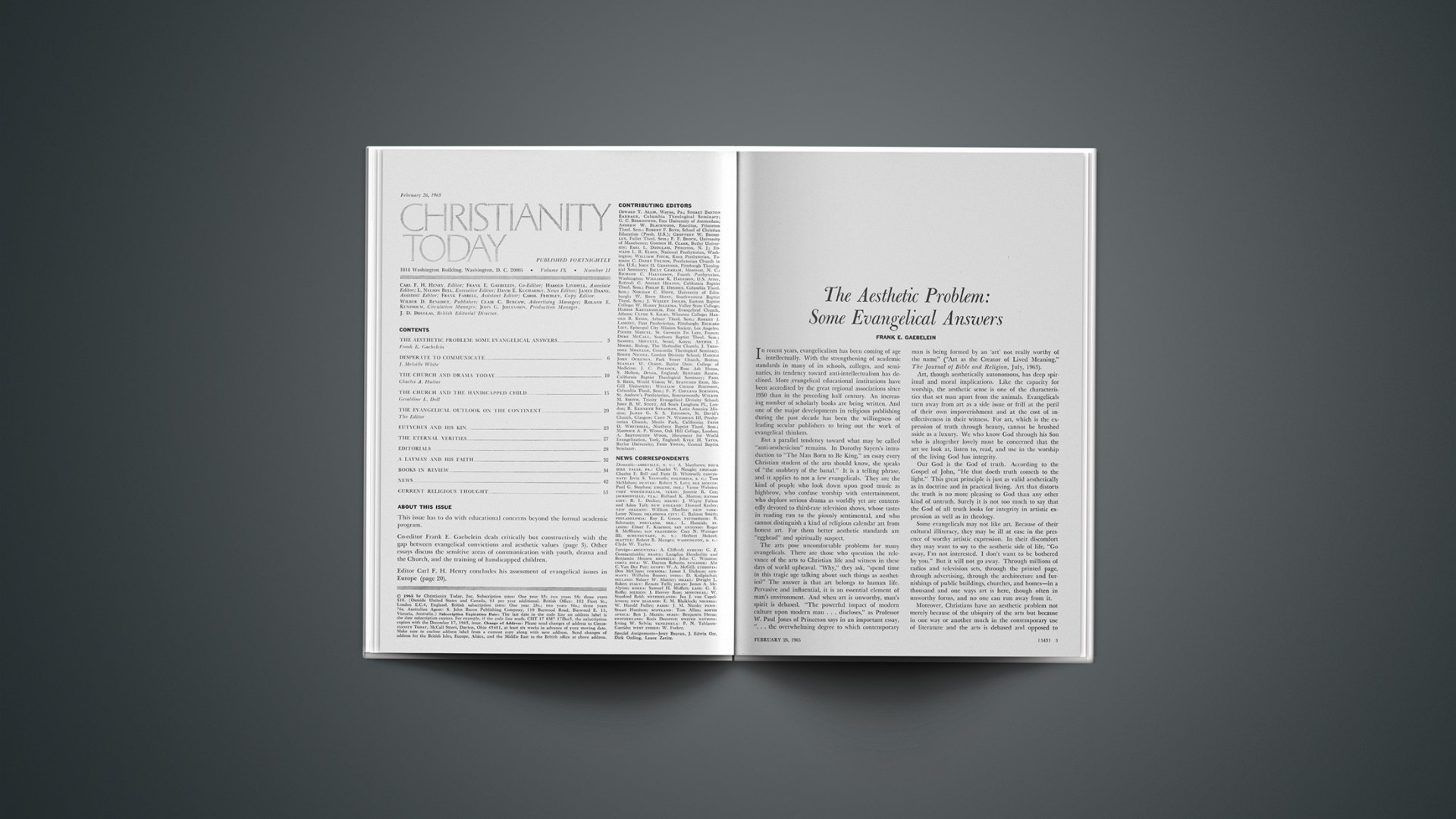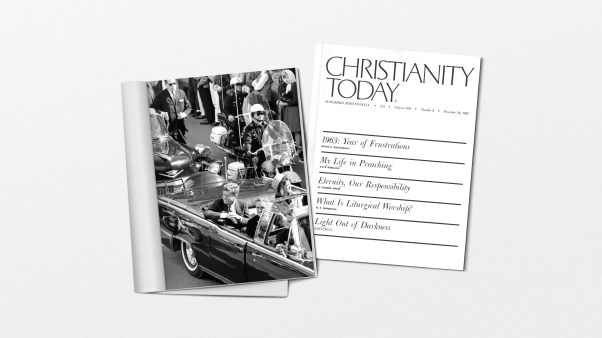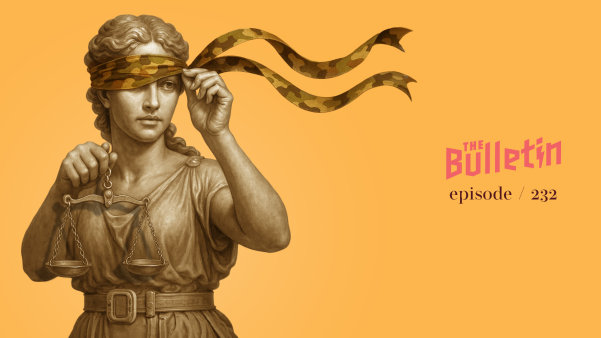In recent years, evangelicalism has been coming of age intellectually. With the strengthening of academic standards in many of its schools, colleges, and seminaries, its tendency toward anti-intellectualism has declined. More evangelical educational institutions have been accredited by the great regional associations since 1950 than in the preceding half century. An increasing number of scholarly books are being written. And one of the major developments in religious publishing during the past decade has been the willingness of leading secular publishers to bring out the work of evangelical thinkers.
But a parallel tendency toward what may be called “anti-aestheticism” remains. In Dorothy Sayers’s introduction to “The Man Born to Be King,” an essay every Christian student of the arts should know, she speaks of “the snobbery of the banal.” It is a telling phrase, and it applies to not a few evangelicals. They are the kind of people who look down upon good music as highbrow, who confuse worship with entertainment, who deplore serious drama as worldly yet are contentedly devoted to third-rate television shows, whose tastes in reading run to the piously sentimental, and who cannot distinguish a kind of religious calendar art from honest art. For them better aesthetic standards are “egghead” and spiritually suspect.
The arts pose uncomfortable problems for many evangelicals. There are those who question the relevance of the arts to Christian life and witness in these days of world upheaval. “Why,” they ask, “spend time in this tragic age talking about such things as aesthetics?” The answer is that art belongs to human life. Pervasive and influential, it is an essential clement of man’s environment. And when art is unworthy, man’s spirit is debased. “The powerful impact of modern culture upon modern man … discloses,” as Professor W. Paul Jones of Princeton says in an important essay, “… the overwhelming degree to which contemporary man is being formed by an ‘art’ not really worthy of the name” (“Art as the Creator of Lived Meaning,” The Journal of Bible and Religion, July, 1963).
Art, though aesthetically autonomous, has deep spiritual and moral implications. Like the capacity for worship, the aesthetic sense is one of the characteristics that set man apart from the animals. Evangelicals turn away from art as a side issue or frill at the peril of their own impoverishment and at the cost of ineffectiveness in their witness. For art, which is the expression of truth through beauty, cannot be brushed aside as a luxury. We who know God through his Son who is altogether lovely must be concerned that the art we look at, listen to, read, and use in the worship of the living God has integrity.
Our God is the God of truth. According to the Gospel of John, “He that doeth truth cometh to the light.” This great principle is just as valid aesthetically as in doctrine and in practical living. Art that distorts the truth is no more pleasing to God than any other kind of untruth. Surely it is not too much to say that the God of all truth looks for integrity in artistic expression as well as in theology.
Some evangelicals may not like art. Because of their cultural illiteracy, they may be ill at ease in the presence of worthy artistic expression. In their discomfort they may want to say to the aesthetic side of life, “Go away, I’m not interested. I don’t want to be bothered by you.” But it will not go away. Through millions of radios and television sets, through the printed page, through advertising, through the architecture and furnishings of public buildings, churches, and homes—in a thousand and one ways art is here, though often in unworthy forms, and no one can run away from it.
Moreover, Christians have an aesthetic problem not merely because of the ubiquity of the arts but because in one way or another much in the contemporary use of literature and the arts is debased and opposed to the truth and to the values to which Christians are obligated. Evangelicals had better be concerned about the aesthetic problem, if for no other reason than that a tide of cheap and perverse artistic expression is constantly eroding the shoreline of noble standards and godly living.
The situation is complicated by the multiplication of leisure hours in this automated age. How many now use their extra hours wisely? Gresham’s law may well have an aesthetic counterpart in that bad art like bad money drives out the good.
Surveying The Situation
As background for some answers to the problem, consider a very brief survey of the aesthetic situation among many evangelicals today with particular reference to music, the visual arts, and literature.
Music is an area in which “the snobbery of the banal” stands in strange contrast to the doctrinal discrimination of many conservative Christians. Not only does the mediocre drive out the good; there is also a certain intolerance of the excellent that refuses to see that great music can be a far more true expression of a biblical theology than piously sentimental music. Or it may be that certain kinds of music finding ready acceptance in some churches reflect a theology that, despite its high claim to orthodoxy, yet leaves much to be desired.
Religious music, however, is not the only music we hear. Much of non-religious music—serious and not just popular in character—betrays the spiritual rootlessness and moral anarchy of the times, as in the strident and heartless works of some of the atonalists or the irrationalities of the avant-garde composers. Thus there is all the more reason for inculcating in God’s people higher standards for this great art that speaks so directly to the emotions and to the spirit.
Look next at the visual arts. Here, as in music, there are great riches. Granted that much in modern painting is related to the spiritual alienation of the day (although not all abstractionism is unworthy), how slight is the acquaintance of many evangelicals with the masters, past and present. How many know the works of American masters like Stuart, Inness, Ryder, Winslow Homer, Cassatt, Marin, or Andrew Wyeth? And what of the priceless treasures of great Christian art through the ages? There is vastly more in religious painting than the ever-present head of Christ that seems almost to have become a Protestant icon.
As for literature, where are the first-rate Christian novels and poems? Evangelicals have made notable progress in scholarly writing, but their achievement in more imaginative forms of literature is mediocre. Christian editors know the paucity of verse by evangelical writers that even begins to qualify as poetry. And in the field of fiction, distinguished novels and short stories written by evangelicals today are almost nonexistent.
Perhaps one thing that holds evangelicals back is a certain cultural parochialism and fear of the world. The moral state of much contemporary literature is indeed appalling. Here the aesthetic problem is a spiritual one that cannot be divorced from the Christian conscience. But there are many books that evangelicals can and must read, including not only the great treasures of English, American, European, and other literature but also representative current writing.
At a Christian teachers’ institute several years ago, I urged breadth of reading and ventured to give a brief list of some of the great works indispensable to a liberal education. In the discussion that followed, a young man asked, “What has Plato to say to a Christian?” The answer is that Plato and every other great writer and artist of the past or present has much to give a Christian not only because it is essential to know the main currents of human thought but also because genius comes only from God. The doctrine of common grace asserts that God distributes his gifts among all kinds of men—unbelievers as well as believers. But the gifts are God’s and the glory is his. Amid the moral corruption of our day, some great and worthy books are being written. Christians need to know them.
In his Concessions, St. Augustine speaks of “the spacious palaces of memory.” It is a wonderful phrase, suggesting Christian responsibility for the furnishing of the mind. But for the fulfillment of this responsibility, there is needed something more enduring than television, the ephemeral popular religious literature of our times, or best-selling Christian records.
Like much else, culture begins at home. Taste is formed by what we live with. The question might well be asked of evangelicals: “What does your home tell of your spiritual and intellectual and aesthetic interests?” Said Rudyard Kipling: “Men and women may sometimes, after great effort, achieve a creditable lie; but a house cannot say anything save the truth of those who have lived in it.” What do the books on the shelves, the magazines on the living room table, the pictures on the walls, the music on the piano, the record collection say of us? What should we read, what should we hear, what should we look at? The Bible has its clear criteria, summed up in the great Pauline phrase, “bringing into captivity every thought to the obedience of Christ.” In Scripture the truth is paramount. Therefore everything that is shoddy and false, even though piously so, is abhorrent to the God of truth.
Some Areas For Action
But this brief survey, which might well be extended to other arts such as drama and architecture, while necessary as diagnosis, points clearly to the need for action. Let us consider, therefore, three proposals toward evangelical answers to the aesthetic problem: (1) The formulation of a Christian theory of aesthetics based first of all upon the insights of the Bible rather than upon extra-biblical sources; (2) the cultivation of good taste and the development of the critical faculty; (3) revision of educational programs to give a more adequate place to the arts.
Consider first the study by evangelicals of the theory of aesthetics. One of the hopeful signs of the last twenty years has been the development of a Christian and biblical philosophy of education. If evangelical education is experiencing renewal, the reason is that evangelical educators have been seriously occupied in considering the theological and philosophical basis of Christian education and in defining its goals.
But so far very little study has been devoted to aesthetics. Indeed, it is difficult to bring to mind a single published book by a conservative evangelical that deals competently with the theology and philosophy of aesthetics. Only comparatively recently have any Protestants given serious thought to this field. Professor W. Paul Jones, in the article previously referred to, says, “Despite a history of virtual indifference to art, Protestant thinkers within the past several decades have begun to explore in earnest the relation of religion to aesthetic matters.” Evangelicals should be joining in this effort. It faces them with an exciting opportunity to explore new paths in applying biblical truths to their cultural milieu.
The bulk of the work being done in the field of Christian aesthetics represents Roman and Anglo-Catholic thought. Its roots go deep into sacramental theology, Thomism, Greek philosophy, and such great writers as Dante. But in large part it is extra-biblical. There is a radical difference between the thought-forms of the Bible and those of Western philosophy and humanistic culture. And while the Bible says little directly about the arts or aesthetics, its basic insights must provide not only the foundation for an authentic Christian aesthetic but also the corrective for artistic theory derived from other sources, however excellent these may be.
Moreover, what some liberal Protestant thinkers have been doing in the field of aesthetics also needs revision, as Professor Jones clearly points out. For Paul Tillich and others like him, he says, art is important because it is chiefly the indicator or “barometer of the ‘faith’ or ‘ultimate concern’ of a generation or culture.” But the difficulty is that such a view of the function of art fails to discriminate between first-rate, second-rate, third-rate art, the latter of which often reflects the present culture more truly than the first!
Art belongs to the only creature made in the image of God, the only creature to whom is given in a limited but real extent the gift of creativity, even though the gift is marred in fallen human nature. Thus considered, it is much more than the faithful mirror of culture. It is far more importantly a way-shower, leading on under God to fuller visions of his truth.
If there is, as we have seen, tension between many evangelicals and the aesthetic aspect of life, the reason lies in a contented ignorance of much that is aesthetically worthy and a satisfaction with the mediocre because it is familiar. Yet theological roots in the eternal biblical verities which never change do not necessarily imply enslavement to aesthetic traditionalism.
An essential element of true aesthetic practice is the adventure of new ideas and their development in new forms. The great artists of the past had in their day an element of newness and spontaneity, and the greater the art the more abiding the newness. In a time when the ugly and the formless have become a cult reflecting the confusion of the pagan world, the creative Christian spirit in art should be pointing the way forward and upward, but always with reference to the everlasting and ever-present truth of him who is “the same yesterday and today and forever.”
A second proposal is that evangelicals must, if they are really to wrestle with the aesthetic problem, take seriously their obligation to develop critical discrimination in the arts. Good models are absolutely essential for sound aesthetic judgment. Good taste is not expensive; it is just discriminating. And it can be developed. Its formation begins very early.
It matters everything what kind of pictures are looked at by children, what kind of music is heard, what kind of television programs are viewed. Art exists in its own right, not just as a vehicle for moralism. Yet it cannot but affect those who are exposed to it. For young people to live day by day with shoddy literature and vulgar entertainment may tear down what they have heard in church and learned in Sunday school. Evangelical churches have picnics and hikes, athletic games and parties for young people—wholesome means of fellowship indeed. Why not also Christian fellowship in group attendance at a symphony concert, or a violin or piano recital? And it is surely not beyond reason for Christians to visit art galleries together. “The way to appreciate beauty,” said Professor William Lyon Phelps of Yale, “is to keep looking at it, to appreciate music is to keep listening to it, to appreciate poetry is to keep reading it.”
Experiences In Nobility
At the end of the first chapter of Romans, after his appalling catalogue of sins within the human heart and life, Paul states the ultimate condemnation of unregenerate man in these words: “They not only do these things but take pleasure in them that do them.” As people look together at what is unworthy and debased aesthetically, they are together debased. But the converse is true. The shared experience of great music or drama, living with good pictures (even in reproductions)—these are group experiences in nobility and, let it be added, in reality. Not all music is joyous, nor does all drama have a happy ending. Yet, as Aristotle shows in his Poetics, tragedy purges the emotions through pity and fear. And at the pinnacle of involvement through experience in the company of others is the reverent worship of the living God, not for the sake of what we get out of it, but because God is God and because worship must be given him.
The time is overdue for evangelicals to outgrow their careless unconcern for aesthetic values and to develop critical standards that will enable them to distinguish good from bad in the art that surrounds them.
The third proposal, obvious but nonetheless important, concerns the more adequate place that the arts ought to have in Christian education. In too many evangelical schools and colleges the arts are little more than poor relatives of the curriculum. Yet in actuality they are not marginal, peripheral subjects; they are close to the heart of Christian life and witness. At present evangelical education is strongest aesthetically in music, although even here it yet has far to go. When it comes to the visual arts like painting and architecture and to the other performing arts, including drama, much of evangelical education is like a fallow field that needs both planting and cultivating. Christian schools and colleges must practice the unity of truth they preach by giving the arts a greater place in the curriculum.
The compelling motive for Christian action in the field of aesthetics lies in the nature of God. Christians are obligated to excellence because God himself is supremely excellent. In the Hall of Fame at New York University, these words are inscribed in the place given Jonathan Edwards, the greatest of American Christian philosophers: “God is the head of the universal system of existence from whom all is perfectly derived and on whom all is most absolutely dependent, whose Being and Beauty is the sum and comprehension of all existence and excellence.” It is because of who and what God is, it is because of the beauty and truth manifest in his Son, it is because of the perfection of his redeeming work, that evangelicals can never be content with the mediocre in aesthetics. Here, as in all else, the call is to the unremitting pursuit of excellence to the glory of the God of all truth.










